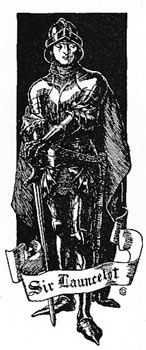

The Vulgate Cycle is a trilogy ('Lancelot Propre', 'La Queste del Saint Graal', and 'La Mort de Roi Artu') thought to have compiled by Cistercian monks between 1215 and 1235. It marks a move from verse to prose in the King Arthur legend.
The affair between Lancelot and Guinevere began with Lancelot being knight by King Arthur, and at the same time falling in love with the queen. Their affair does not actually become adultery until Galehaut, King of the Long Isles and Lord of Surluse, makes war on Arthur. An unknown knight in black armour comes to Arthur's aid at the last moment. Galehaut is impressed by the Black Knight's prowess and gallantry and agrees to make peace with Arthur. Galehaut discovers that the black knight is often red-eyed from sadness, sadness because of his love for Guinevere. Galehaut arranges a meeting between the black knight and Guinevere.
So Guinevere and Lancelot are thrown together. Morgan le Fay, is introduced as an anti-heroine.
In the Vulgate Cycle's 'La Mort de Roi Artu' Arthur's army lays siege to Lancelot in his castle Joyous Garde, with Gawain looking for vengeance against Lancelot, as Lancelot had killed his brothers while rescuing Guinevere from the stake. A single combat between Lancelot and Gawain ensues, and ends with Lancelot being reluctant to administer the coup de grace to his old friend in the best traditions of chivalry
The Vulgate Cycle was an important source for Sir Thomas Malory in Le Morte d'Arthur (1485) and which he referred to it as "the French book".